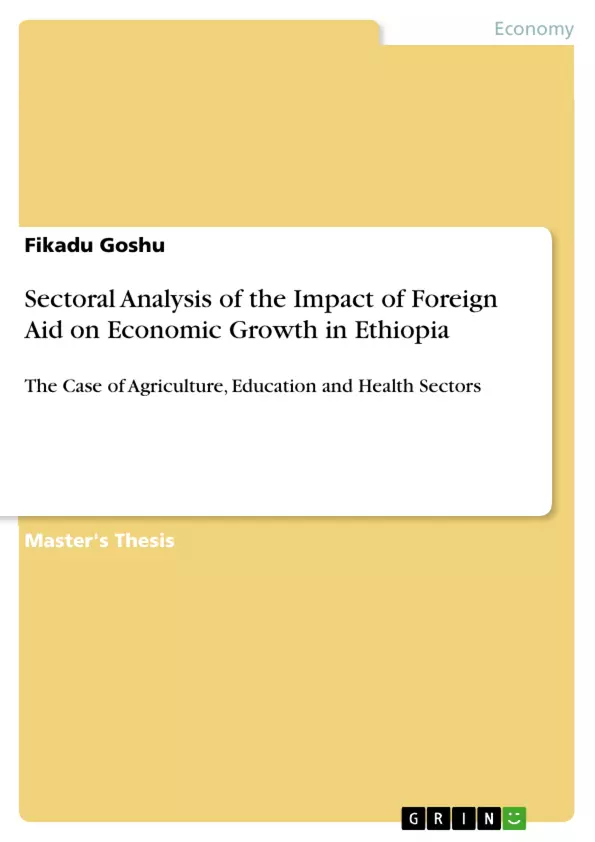This study has examined sectoral analysis of the impact of foreign aid on aggregate and sectoral economic growth in Ethiopia over the period 1981 to 2012 using multivariate Vector auto regression analysis. All the necessary time series tests such as stationary test, co-integration test, weak exiguity test, vector error correction, and causality test in vector error correction model and the like are conducted. The empirical result from the growth equation shows that aid has a significant positive impact on educational sector GDP in the long run. On the other hand, foreign aid has positive but insignificant impact on real GDP, agriculture GDP, and health sector GDP of Ethiopia. Foreign aid is effective in enhancing growth at aggregate level of the economy in general and education sector of the economy of Ethiopia in particular. The test result of the study result reveals that there is a bi-directional causal relationship between educational GDP and educational foreign aid in Ethiopia. However, the agricultural and health sector does not show any bi-directional causality with their respective sector aid. This implies that all aid allocated for sectors is ineffective all in all in achieving its objectives of economic development. Therefore, aid recipient country like Ethiopia has to work how to enhance the domestic revenue raising capacity of the country which is at the heart of the mechanism to meet the capital required for the economy in times of short falls and ineffectiveness of external resources.
Inhaltsverzeichnis (Table of Contents)
- CHAPTER ONE: INTRODUCTION
- 1.1. Background
- 1.2. Statement of the Problem
- 1.3. Objective of the Study.
- 1.3.1. General Objectives
- 1.3.2. Specific Objectives........
- 1.4. Research Questions.
- 1.5. Hypothesis to be Tested...
- 1.6. Significance of the Study......
- 1.7. Scope and Limitation of the Study
- 1.7.1. Scope of the Study.
- 1.7.2. Limitation of the Study..
- 1.8. Organization of the Paper...
- CHAPTER TWO: METHODOLOGY OF THE STUDY
- 2.1. Data Types and Sources
- 2.2. Description of Variables..
- 2.3. Model Specification.
- 2.4. Econometric Estimation Techniques ..........\li>
- 2.4.1. Testing for Unit Root..
- 2.4.2. Test for Cointegration
- 2.4.3 Vector Error Correction Model
- 2.4.4 Causality Test in Vector Error Correction Model
- CHAPTER TREE: RESULT AND DISCUSSION..
- 3.1. Descriptive Analysis of Macroeconomic Performance in Ethiopia
- 3.1.1. Analysis of Aggregate Economic Growth in Ethiopia. ...........
- 3.1.2. Sector Wise Analysis of Economic Growth in Ethiopia
- 3.1.3. Trends of Domestic Savings and Investment in Ethiopia....
- 3.1.4. Trends of External Sector Economic Growth in Ethiopia.
- 3.1.5. Government Expenditure and Economic Growth............
- 3.1.6. Foreign Aid (ODA) and Economic Growth in Ethiopia............
- 3.1.7. Sectorial Composition of Foreign Aid (ODA) in Ethiopia....
- 3.2. Empirical Results Analysis and Interpretations...
- 3.2.1. Results for Unit-Root Test
- 3.2.2. Co-integration and Long run Growth Equation Analysis..
- 3.2.3. Short Run VECM Estimation of Economic Growth.
- 3.2.4. Causality Analysis of Aggregate and Sectoral Economic Growth.
- CHAPTER FOUR: SUMMARY AND CONCLUSION
- 4.1. Summary
- 4.2. Conclusion.......
- 4.3. Policy Implication
Zielsetzung und Themenschwerpunkte (Objectives and Key Themes)
This thesis investigates the impact of foreign aid on economic growth in Ethiopia, specifically analyzing its effect on the agriculture, education, and health sectors. The study seeks to determine the extent to which foreign aid contributes to economic growth in these sectors, and to identify any potential causal relationships between aid and growth.- The impact of foreign aid on economic growth in Ethiopia.
- The sectoral impacts of foreign aid, specifically on the agriculture, education, and health sectors.
- The causal relationship between foreign aid and economic growth in Ethiopia.
- The role of macroeconomic factors in influencing the impact of foreign aid on economic growth.
- Policy implications of the findings for improving the effectiveness of foreign aid in Ethiopia.
Zusammenfassung der Kapitel (Chapter Summaries)
- Chapter One provides a comprehensive introduction to the study, outlining the background of the research, the statement of the problem, the objectives, research questions, and the hypothesis to be tested. It also discusses the significance of the study, the scope and limitations, and the organization of the paper.
- Chapter Two details the methodology used in the study, including the data types and sources, the description of the variables, the model specification, and the econometric estimation techniques employed. It covers methods for testing for unit roots, cointegration, and the Vector Error Correction Model (VECM), along with causality testing within the VECM framework.
- Chapter Three presents the results and discussion of the empirical analysis. This chapter encompasses a descriptive analysis of macroeconomic performance in Ethiopia, covering aggregate economic growth, sector-wise growth, domestic savings and investment trends, external sector growth, government expenditure, foreign aid (ODA) trends, and the sectoral composition of foreign aid. It also includes the empirical results and interpretations of the unit-root test, cointegration and long-run growth equation analysis, short-run VECM estimation of economic growth, and causality analysis of aggregate and sectoral economic growth.
Schlüsselwörter (Keywords)
The main keywords and focus topics of this study are foreign aid, economic growth, Ethiopia, agriculture, education, health, sectorial analysis, econometric estimation, unit root, cointegration, Vector Error Correction Model (VECM), causality analysis. The study utilizes empirical research methodologies to examine the impact of foreign aid on economic growth in Ethiopia, with a particular focus on the agriculture, education, and health sectors. Key concepts include the effectiveness of foreign aid, the potential for economic growth, and the importance of sector-specific analysis.- Citation du texte
- Fikadu Goshu (Auteur), 2014, Sectoral Analysis of the Impact of Foreign Aid on Economic Growth in Ethiopia, Munich, GRIN Verlag, https://www.grin.com/document/283048



